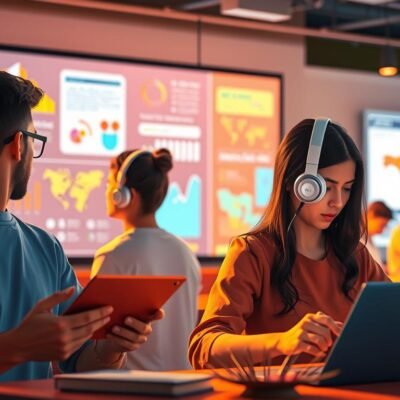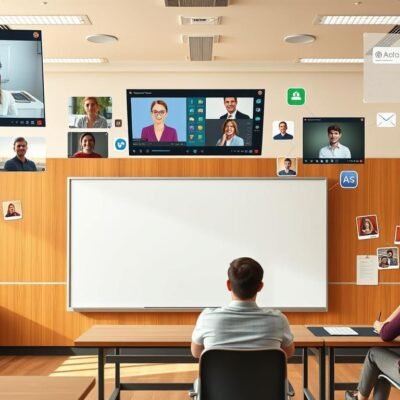
Technology shapes nearly every part of modern life, yet millions still lack basic access to digital tools. This gap affects job opportunities, healthcare, and education. While smartphones connect many, true digital literacy requires more than just devices.
E-learning tools now offer flexible solutions for communities with limited resources. From rural towns to underserved urban areas, these systems deliver quality instruction through adaptable formats. Interactive courses work on low-bandwidth connections, while downloadable materials help those with unreliable internet.
Studies show tailored programs boost engagement across age groups and income levels. Mobile-first designs meet users where they are, using familiar devices like phones or tablets. This approach builds skills without requiring expensive computers.
Key Takeaways
- The digital divide creates unequal access to technology based on income, location, and age
- Adaptive e-learning systems provide education through low-cost devices and basic internet
- Customizable content helps diverse learners gain job-ready skills at their own pace
- Community partnerships expand tech access through libraries and local centers
- Continuous updates keep courses relevant in fast-changing industries
Understanding the Digital Divide and Its Impact on Education
Education today relies heavily on technology, but not everyone can keep up. Imagine needing to complete homework without a laptop or struggling to stream lessons with spotty Wi-Fi. These are daily realities for millions globally.

Identifying the Gap in Digital Literacy and Infrastructure
Many families face a triple threat: outdated devices, weak connectivity, and limited know-how. In rural regions, cell towers might be miles apart. Urban neighborhoods often have Wi-Fi networks nearby, but subscription costs remain out of reach.
Teachers in underserved schools frequently lack training to use modern tools effectively. A student might own a smartphone but not understand cloud storage. Older adults miss out on job skills training because apps confuse them.
Challenges Faced by Remote and Under-Resourced Communities
Farm towns face infrastructure gaps—broadband cables rarely reach cornfields. Meanwhile, city apartments might share one tablet among three siblings. Both scenarios limit learning time and quality.
Affordability issues force tough choices: pay for groceries or a data plan. Public libraries help, but their computers book up fast. Without consistent access, students fall behind peers in tech-rich areas.
How online learning platforms are bridging the digital divide: Best Practices
Innovative services now deliver knowledge through methods matching real-world limitations. Leading platforms combine affordability with flexibility, creating paths for those previously left behind.

Leveraging Affordable, Accessible Digital Learning
Top-tier resources no longer require deep pockets. Services like Coursera partner with universities to offer free certifications in high-demand fields. Duolingo turns language skills development into bite-sized mobile games.
Offline features let users download courses during brief internet windows. Farmers can study crop management techniques between chores. Commuters learn coding basics during subway rides without cellular service.
Enhancing Digital Literacy Through Personalized Online Tools
Platforms build tech confidence through intuitive design. Khan Academy’s dashboard guides learners step-by-step, mixing video lessons with practice exercises. Built-in tutorials explain how to navigate menus and submit assignments.
Adaptive systems adjust difficulty based on performance. Struggling students get extra practice problems. Advanced learners unlock bonus material. SMS quizzes help rural users with basic phones build digital literacy gradually.
These approaches turn everyday devices into powerful classrooms. A shared tablet becomes a programming lab. An older smartphone transforms into a business training center. Education grows beyond traditional settings.
Embracing EdTech and Innovative Solutions
Your smartphone holds more educational power than you might realize. Across America, creative tech solutions turn everyday devices into classrooms for those lacking traditional resources.
Integrating Mobile Learning and Adaptive Technologies
Basic phones become lifelines where laptops are scarce. Farmers in Iowa use SMS quizzes to study crop rotation. Bus drivers in Chicago learn coding through voice-based lessons during breaks. These methods work on 3G networks and older devices.
Platforms like DreamBox prove math doesn’t require fancy equipment. Their adaptive system adjusts problems based on your answers. Struggling? It serves easier questions. Mastering concepts? You unlock advanced material automatically.
The Role of AI in Personalized Digital Education
Artificial intelligence acts like a 24/7 tutor in your pocket. Smart Sparrow’s chemistry courses change experiments based on your learning style. Visual learners get 3D molecule models. Hands-on types receive virtual lab simulations.
These systems spot knowledge gaps instantly. Miss a key concept in algebra? The AI circles back with targeted practice before moving forward. This personalized approach helps urban and rural learners alike build job-ready skills efficiently.
Virtual welding simulators in community colleges show tech’s practical side. Students gain trade experience through augmented reality goggles, eliminating expensive equipment costs. Such innovations make digital transformation tangible for all income levels.
Building Robust Digital Infrastructure for Inclusive Learning
Strong digital foundations transform classrooms from isolated hubs to connected learning centers. Reliable internet access and modern tools empower students in rural towns and urban neighborhoods alike.
Cutting-edge initiatives prove progress is possible. Google’s Project Loon delivers Wi-Fi via stratospheric balloons, while SpaceX’s Starlink blankets remote areas with satellite signals. These breakthroughs make connectivity achievable where fiber cables can’t reach.
Public-Private Partnerships and Technology Investments
Governments and tech giants now collaborate to equip schools with tablets, learning apps, and teacher coaching. Through economic inclusion programs, districts receive:
- Solar-powered computer labs for off-grid communities
- Interactive whiteboards with localized curriculum content
- Professional development workshops for educators
Teacher training remains critical. Upskilling programs show instructors how to blend tech tools with traditional teaching methods. A biology teacher might use AR anatomy apps alongside textbook diagrams, creating hybrid lessons that engage digital natives.
Policy frameworks ensure investments reach those most in need. States prioritize schools lacking basic electricity before rolling out advanced equipment. This phased approach builds sustainable digital infrastructure that evolves with community needs.
Conclusion
The journey toward educational equity is gaining momentum through smart tech solutions. You’ve seen how collaborative efforts between governments, schools, and companies create accessible pathways for skill development. These partnerships address both device shortages and knowledge gaps, turning basic phones into powerful learning tools.
Building sustainable digital infrastructure remains crucial. Reliable internet and localized content help communities overcome geographical barriers. A recent study highlights how a holistic approach combining connectivity with cultural relevance boosts engagement in rural areas.
Personalized learning experiences through AI adapt to individual needs, making education more inclusive. Farmers master crop techniques via SMS courses, while urban teens code using shared tablets. These innovations prove quality instruction doesn’t require expensive resources.
Your role matters too. Supporting community tech centers and advocating for policy changes helps maintain progress. Together, we can ensure technology becomes a true equalizer—one lesson at a time.



